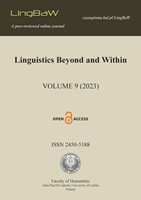Representing temporal concepts using redundant gestures in L2 ongoing interactions
Representing temporal concepts using redundant gestures in L2 ongoing interactions
Author(s): Hiroki HanamotoSubject(s): Media studies, Sociolinguistics, Theory of Communication
Published by: Wydawnictwo KUL
Keywords: Redundant gesture; multimodality; temporal concept; L2 interaction;
Summary/Abstract: Human conversational interaction is multimodal, involving both verbal and non-verbal modalities. That is, when a speaker and listener interact, they use not only spoken messages but also manual gestures. Manual gestures and spoken messages are semantically and temporally related and work together to create and express a complete meaning. This study employs a data-driven approach to investigate how L2 learners spontaneously employ gestures to express temporal concepts in ongoing dyadic interactions using 11 recorded interactions among L2 learners. The distribution and frequency of specific types of manual gestures were examined using sequential and gesture analyses. The results showed that, when representing temporal concepts, the participants produced language-redundant gestures. For example, to convey temporal concepts, they tended to co-express the same information with manual gestures, namely abstract deictic and metaphoric gestures, on an imaginary mental timeline axis, which appeared to represent the English grammatical concepts of tense and aspectual meaning. Regarding the functional differences in gestures in interactions, based on sequential analysis, speakers employed language-redundant gestures to express time concepts explicitly in comprehension sequences and in the negotiation of meaning as a strategy of repair for lexical retrieval, paraphrasing, and clarification. These findings reveal that understanding the use of both modalities, speech and gestures, is critical in uncovering how speakers conceptualize time in their minds and integrate space and time in language.
Journal: Linguistics Beyond and Within (LingBaW)
- Issue Year: 9/2023
- Issue No: 9
- Page Range: 36-48
- Page Count: 13
- Language: English

